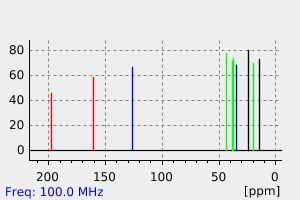芹菜酮 | 3720-16-9
中文名称
芹菜酮
中文别名
利福酮;3-甲基-5-丙基-2-环己烯-1-酮
英文名称
3-methyl-5-propyl-2-cyclohexen-1-one
英文别名
(2-cyclohexen-1-one,3-methyl-5-propyl);3-methyl-5-propylcyclohex-2-en-1-one;3-methyl-5-propyl-2-cyclohexenone;3-methyl-5-propylcyclohex-2-enone;3-methyl-5-butyl-2-cyclohexenone;1-methyl-5-propyl-cyclohexen-3-one
CAS
3720-16-9
化学式
C10H16O
mdl
MFCD00482082
分子量
152.236
InChiKey
URQMEZRQHLCJKR-UHFFFAOYSA-N
BEILSTEIN
——
EINECS
——
-
物化性质
-
计算性质
-
ADMET
-
安全信息
-
SDS
-
制备方法与用途
-
上下游信息
-
文献信息
-
表征谱图
-
同类化合物
-
相关功能分类
-
相关结构分类
物化性质
-
沸点:110-113 °C(Press: 9 Torr)
-
密度:0.904±0.06 g/cm3(Predicted)
-
LogP:2.5 at pH7
-
表面张力:53.2mN/m at 1g/L and 21℃
-
物理描述:Pale yellow to colourless liquid; warm spicy woody odour, similar flavor at low levels
-
溶解度:insoluble in water; soluble in ether and oils
-
折光率:1.481-1.486
计算性质
-
辛醇/水分配系数(LogP):2.3
-
重原子数:11
-
可旋转键数:2
-
环数:1.0
-
sp3杂化的碳原子比例:0.7
-
拓扑面积:17.1
-
氢给体数:0
-
氢受体数:1
安全信息
-
海关编码:2914299000
-
储存条件:2-8℃,干燥保存。
SDS
制备方法与用途
性状: 透明黄色液体
反应信息
-
作为反应物:描述:参考文献:名称:脱苯酚摘要:DOI:10.1021/ie50511a057
-
作为产物:描述:1-三甲基硅烷-1-己炔 在 sodium hydroxide 、 正丁基锂 、 双三氟甲烷磺酰亚胺 、 lithium hexamethyldisilazane 作用下, 以 四氢呋喃 、 甲醇 、 正己烷 、 二氯甲烷 、 水 为溶剂, 反应 10.0h, 生成 芹菜酮参考文献:名称:Brønsted Acid-Promoted Cyclizations of Siloxyalkynes with Arenes and Alkenes摘要:We have described the first Brønsted acid-mediated cyclizations of siloxyalkynes with simple arenes and alkenes to afford substituted tetralone and cyclohexenone derivatives. The most notable aspect of the carbocyclizations involving siloxyalkynes is the ability to employ a range of substrates that are not restricted to those containing electron-rich arenes and alkenes. The key mechanistic feature of the reaction is the generation of a highly reactive ketenium ion upon protonation of siloxyalkyne. We believe that the low nucleophilicty of the counteranion is crucial for enabling the formation and effective interception of this highly reactive intermediate.DOI:10.1021/ja046586x
文献信息
-
[EN] COMPOUNDS FOR A CONTROLLED RELEASE OF ACTIVE PERFUMING MOLECULES<br/>[FR] COMPOSÉS POUR UNE LIBÉRATION CONTRÔLÉE DE MOLÉCULES PARFUMANTES ACTIVES申请人:FIRMENICH & CIE公开号:WO2013139766A1公开(公告)日:2013-09-26The present invention relates to the field of perfumery. More particularly, it concerns compounds comprising at least one β-thio carbonyl or nitrile moiety capable of liberating an active molecule selected from an α,β-unsaturated ketone, aldehyde or nitrile. The present invention concerns also the use of said compounds in perfumery as well as the perfuming compositions or perfumed articles comprising the invention's compounds. (I) wherein: a) m represents an integer from 1 to 6; b) Pro represents a hydrogen atom or a group susceptible of generating an odoriferous α,β-unsaturated ketone, aldehyde or nitrile and is represented by the formulae (II) or (II') in which the wavy line indicates the location of the bond between said Pro and the sulfur atom S; and at least one of the Pro groups is of the formula (II) or (II').
-
[EN] HYDROLYTICALLY LABILE PRO-FRAGRANCES CONTAINING α,β UNSATURATED ESTERS<br/>[FR] PRO-PARFUMS HYDROLYTIQUEMENT LABILES CONTENANT DES ESTERS α,β INSATURÉS申请人:HENKEL AG & CO KGAA公开号:WO2020058058A1公开(公告)日:2020-03-26The present invention pertains to pro-fragrances and relates to a pro-fragrance compound of the formula (I). Furthermore, the invention relates to compositions, a laundry product, a home care product, and an insect repellant, comprising the compound of formula (I). Also encompassed are a method for preparing the compound of formula (I) and uses of a compound of formula (I) for increasing the longlastingness of a fragrance, for increasing the stability and perception of a fragrance, and for improving the adhesion of a fragrance to textiles.
-
[EN] 3-(2-ALKOXYCARBONYLOXY-PHENYL) ACRYLIC ACID ESTERS AND THEIR USE AS PRECURSORS FOR THE DELIVERY OF OLFACTORY COMPOUNDS<br/>[FR] ESTERS D'ACIDE 3-(2-ALCOXYCARBONYLOXY-PHENYL) ACRYLIQUE ET LEUR UTILISATION COMME PRECURSEURS POUR L'ADMINISTRATION DE COMPOSES OLFACTIFS申请人:GIVAUDAN SA公开号:WO2005077881A1公开(公告)日:2005-08-25A compound of formula (I), their use as precursors and a method of their production wherein n, Y, R, R2, R3, and R4 has the same meaning as given in the specification.一种具有式(I)的化合物,它们作为前体的用途以及它们的制备方法,其中n、Y、R、R2、R3和R4的含义与规范中给出的含义相同。
-
BITTER TASTE MODIFIERS INCLUDING SUBSTITUTED 1-BENZYL-3-(1-(ISOXAZOL-4-YLMETHYL)-1H-PYRAZOL-4-YL)IMIDAZOLIDINE-2,4-DIONES AND COMPOSITIONS THEREOF申请人:SENOMYX, INC.公开号:US20160376263A1公开(公告)日:2016-12-29The present invention includes compounds and compositions known to modify the perception of bitter taste, and combinations of said compositions and compounds with additional compositions, compounds, and products. Exemplary compositions comprise one or more of the following: cooling agents; inactive drug ingredients; active pharmaceutical ingredients; food additives or foodstuffs; flavorants, or flavor enhancers; food or beverage products; bitter compounds; sweeteners; bitterants; sour flavorants; salty flavorants; umami flavorants; plant or animal products; compounds known to be used in pet care products; compounds known to be used in personal care products; compounds known to be used in home products; pharmaceutical preparations; topical preparations; cannabis-derived or cannabis-related products; compounds known to be used in oral care products; beverages; scents, perfumes, or odorants; compounds known to be used in consumer products; silicone compounds; abrasives; surfactants; warming agents; smoking articles; fats, oils, or emulsions; and/or probiotic bacteria or supplements.本发明涵盖已知用于改变苦味感知的化合物和组合物,以及所述组合物和化合物与额外的组合物、化合物和产品的组合。示例组合物包括以下一种或多种:冷却剂;无活性药物成分;活性药用成分;食品添加剂或食品;调味剂或调味增强剂;食品或饮料产品;苦味化合物;甜味剂;苦味剂;酸味调味剂;咸味调味剂;鲜味调味剂;植物或动物产品;已知用于宠物护理产品中的化合物;已知用于个人护理产品中的化合物;已知用于家用产品中的化合物;制药制剂;局部制剂;大麻衍生或与大麻相关的产品;已知用于口腔护理产品中的化合物;饮料;香味、香水或除臭剂;已知用于消费品中的化合物;硅化合物;磨料;表面活性剂;发热剂;吸烟物品;脂肪、油脂或乳化剂;和/或益生菌或补充剂。
-
Aldol Reaction and Robinson-Type Annelation Catalyzed by Lanthanoid Triisopropoxides作者:Tamon Okano、Yoshikazu Satou、Motoshi Tamura、Jitsuo KijiDOI:10.1246/bcsj.70.1879日期:1997.8Lanthanoid triisopropoxides are active catalysts for aldol reactions. Aldehydes give the corresponding β-hydroxyaldehydes at low temperatures in good yields, whereas ketones are less reactive, but form condensation products at high temperatures. Exceptionally, γ- or δ-diketones easily undergo condensation to give five- and six-membered unsaturated ketones in high yields. The lanthanoid propoxides, catalyzing the Michael addition of ketones to α,β-unsaturated ketones, which give δ-diketones, are also good catalysts for the Robinson-type annelation. In these reactions, the catalytic activity of the lanthanum propoxide is higher than those of the heavy lanthanoid propoxides, and is almost comparable to that of sodium isopropoxide. Since aluminum triisopropoxide shows poor activity, the lanthanoid propoxides are considerably basic for trivalent metal alkoxides.
表征谱图
-
氢谱1HNMR
-
质谱MS
-
碳谱13CNMR
-
红外IR
-
拉曼Raman
-
峰位数据
-
峰位匹配
-
表征信息
同类化合物
(反式)-4-壬烯醛
(s)-2,3-二羟基丙酸甲酯
([1-(甲氧基甲基)-1H-1,2,4-三唑-5-基](苯基)甲酮)
(Z)-4-辛烯醛
(S)-氨基甲酸酯β-D-O-葡糖醛酸
(S)-3-(((2,2-二氟-1-羟基-7-(甲基磺酰基)-2,3-二氢-1H-茚满-4-基)氧基)-5-氟苄腈
(R)-氨基甲酸酯β-D-O-葡糖醛酸
(5,5-二甲基-2-(哌啶-2-基)环己烷-1,3-二酮)
(2,5-二氟苯基)-4-哌啶基-甲酮
龙胆苦苷
龙胆二糖甲乙酮氰醇(P)
龙胆二糖丙酮氰醇(P)
龙胆三糖
龙涎酮
齐罗硅酮
齐留通beta-D-葡糖苷酸
鼠李糖
黑芥子苷单钾盐
黑海棉酸钠盐
黑木金合欢素
黑曲霉三糖
黑介子苷
黄尿酸8-O-葡糖苷
麻西那霉素II
麦迪霉素
麦芽糖脎
麦芽糖基海藻糖
麦芽糖1-磷酸酯
麦芽糖
麦芽四糖醇
麦芽四糖
麦芽十糖
麦芽六糖
麦芽五糖水合物
麦芽五糖
麦芽五糖
麦芽五糖
麦芽三糖醇
麦芽三糖
麦芽三糖
麦芽三塘水合
麦芽七糖水合物
麦芽七糖
麦法朵
麦可酚酸-酰基-Β-D-葡糖苷酸
麦利查咪
麝香酮
鹤草酚
鸢尾酚酮 3-C-beta-D-吡喃葡萄糖苷
鸡矢藤苷







